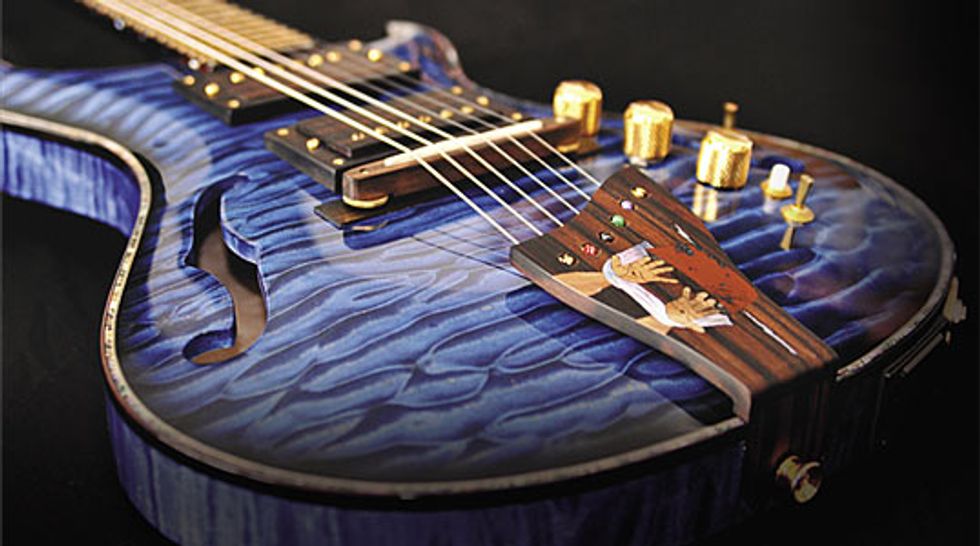 | |
|
Forest City, Iowa sits quietly at the intersection of Highway 69 and Route 9 in far northern Iowa, surrounded by waving fields of corn in the summer and buried beneath snow and ice in the winter. This town of 4500 has all of the hallmarks of a Midwestern locale; a Pizza Hut and non-descript Ford dealership stand at the highway entrance, while mention of Winnebago Industries – the area’s largest employer – seems to find its way into every conversation. Forest City has a sleepy, contented air about it, and may be exactly the last place one would expect to find one of the industry’s premier custom builders.
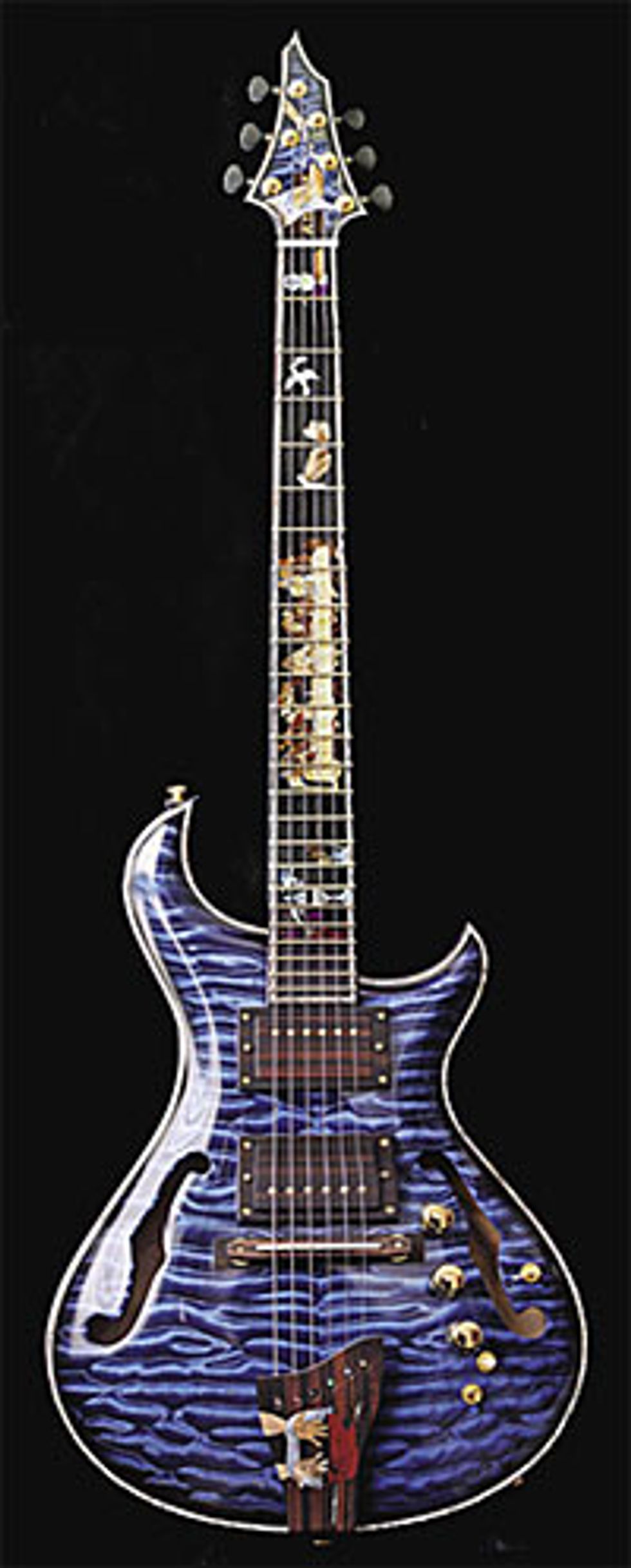 Presentation Elect #14 with Last Supper inlay |
What’s even more refreshing is the excitement he has for his work. While some artists grow jaded and cynical when discussing the intersection of craft and commerce, Kevin operates with genuine excitement, gladly welcoming you into his home to talk about the world of custom building. Without any prodding, he excitedly flips open case after case to show you his latest projects, full of eye-popping inlays and gorgeous, figured woods. Every guitar embodies luthiery taken to a higher degree, but they are not museum pieces. When he senses any hesitation to touch his instruments – to instinctively reach out, as one might with a more familiar instrument – he thrusts the guitar deep into your hands. “These are instruments,” he says with a smile. “They are meant to be played.”
It has been an incredible evolution for a man who once took a job in a cabinet shop, knowing little about the technology or processes of woodwork. These days, Kevin spends his time honing his designs and brainstorming ways to implement the myriad ideas in his head – his new Drea Armani archtop is proof of this, combining unique beauty with player-focused functionality. His Presentation Elect models – guitars commissioned by customers but left entirely to Kevin’s muses – remain in heavy demand by both domestic and international buyers, and he hints that an expansion to a larger shop and the hiring of another set of hands may be closer than even he’s expected.
In the next evolutionary step for his company, he will no longer be producing Abyss Guitars. As you read this, Kevin will be changing the name on each headstock to Kevin L. Pederson Custom Guitars, all in an attempt to identify himself more closely with his work. As with any name change, there’s a sense of uncertainty and anxiety surrounding the move – questions about the loyalty of customers and corporate identity arise – but he remains upbeat and positive about the possibilities ahead of him. We talked with Kevin about how far he’s come, what the name change means for him and his thoughts on doing business one guitar at a time.
I’d like to start by going back to the beginning. What was the inspiration for you learning how to build guitars?
Well, the inspiration has always been my love for the guitars and art. I’ve played in bands and stuff – rock bands and metal bands – and my love for the guitar has always been there. But I got to a point where I was pretty ambitious with basically nothing to do, sitting around and thinking, “What can I do to make some money?” So my wife suggested that I make a guitar – that’s usually how it starts! [laughs]
At first, I was like, “You can’t make a guitar – you’ve got the neck and all of that!” I was trying to talk her down, but lo and behold, a couple years later I got into a cabinet shop, where I got some woodworking experience. After that, I thought, “Hey, this might be doable.”
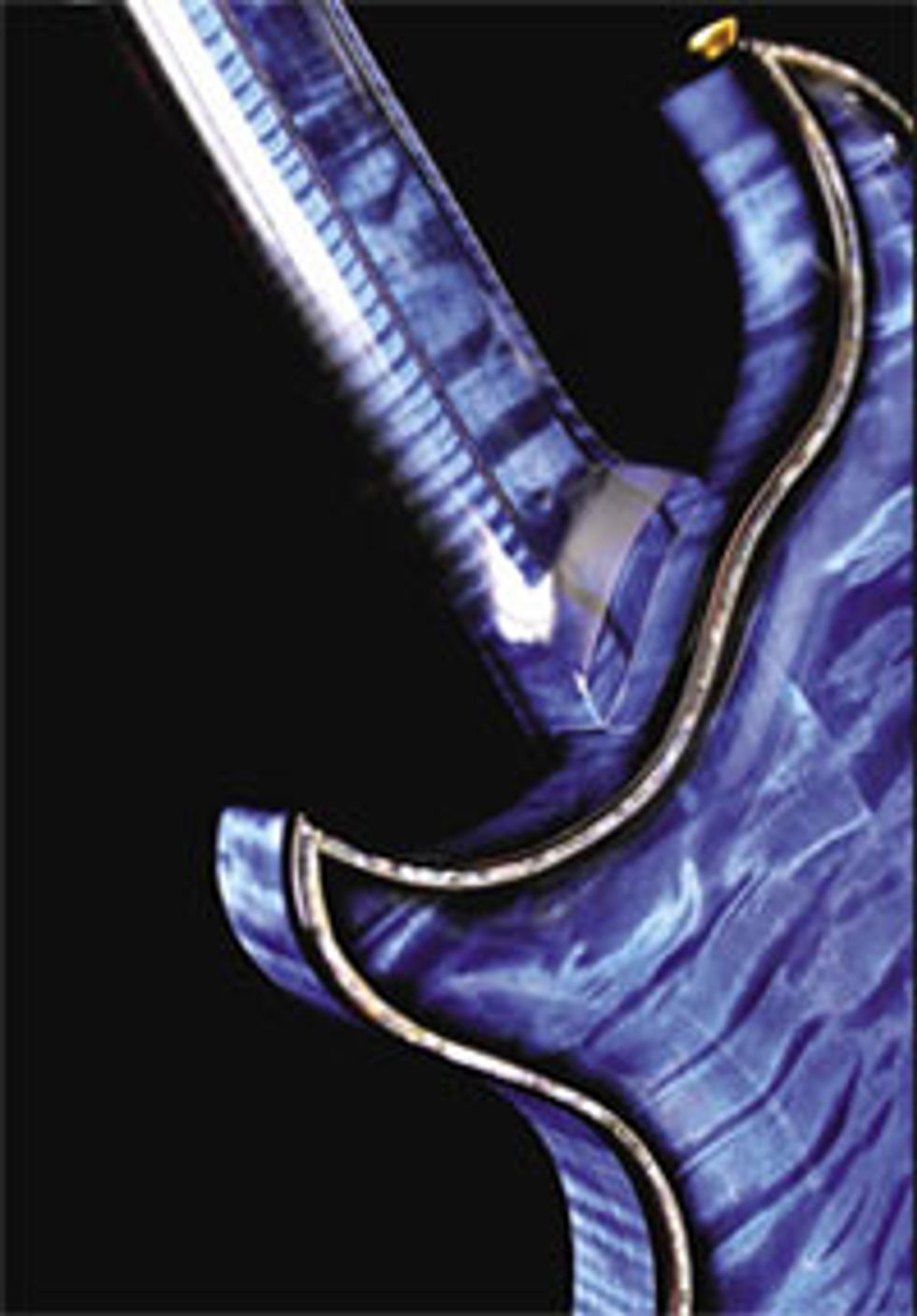 When was that?
When was that? That would be around 1992 or ’93, and I actually took her up on that challenge around 1995. That’s the year I started tinkering with guitars. I would order a body and a neck and just see how it all fit together.
Like the kits you can buy today?
Yeah, except that back then they didn’t distribute all the parts as a kit. It was like, here’s the body, here’s the neck, here’s some parts – there were no instructions. I built one guitar and thought, “Hey, that’s pretty cool!” It was like an Eddie Van Halen guitar, because I wanted to buy one of those EVHs back in the early nineties but I couldn’t afford it. So then I bought supplies to make a guitar and I thought, “If this totally fails, at least I’ve got the tools.”
That seems like a gutsy move, especially considering you didn’t even know where to source your woods. How did you develop those contacts?
One thing that helped me when I first started was that I was pretty ignorant and I asked people some pretty crazy questions. Those questions got me moving in the right direction. One thing that I felt helped me was that once I located a vendor, I was willing to put down a little extra money to buy in bulk, instead of just buying one top. I went to the vendor and said, “Hey, if I buy ten [tops] from you, would you give me a little better deal?” And that helped develop a relationship with that guy, because he sent me great wood. He’s thinking, “If I deliver and this wood’s great, he’s going to be back for more, and then we’re both happy.”
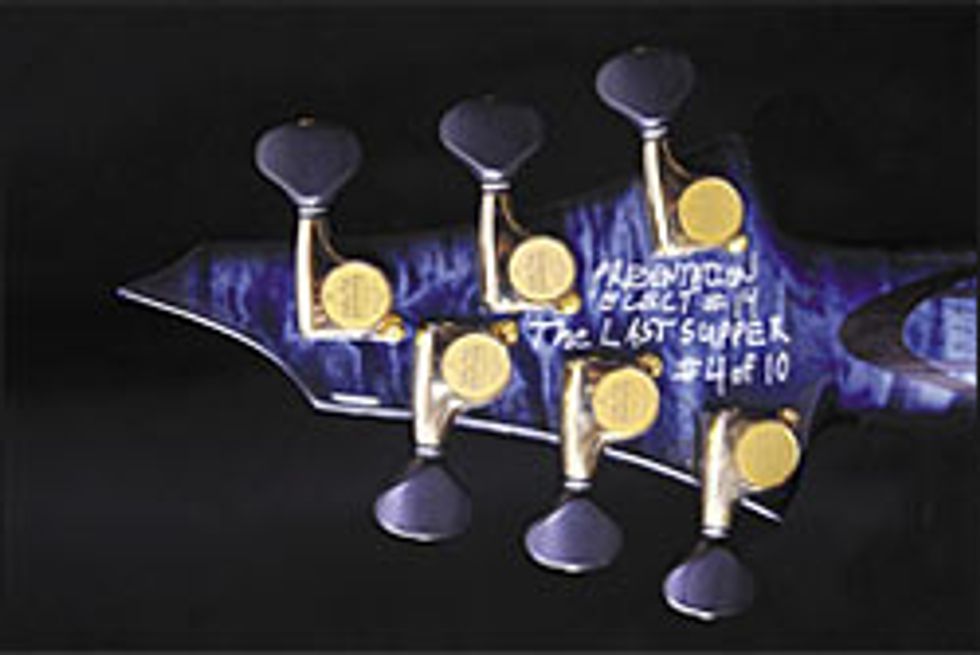 So all of the sudden you had ten really nice tops.
So all of the sudden you had ten really nice tops. Yeah, I started out with ten really nice quilt tops, amongst a lot of other woods. And then my building started morphing; after I made the second guitar, and it worked, I thought, “I can improve.” Then I made another one, and that was a little better. And then I ran out of money! That’s when a friend of mine said, “Hey, I’ll buy the parts if you’ll build it.” So he bought a piece of koa from Hawaii…
The thought of someone just picking up a nice piece of koa is baffling these days!
It wasn’t the commodity it is now – it’s like oil now, you know? Gold! But he bought the piece and I put it together. That was also the first time I did inlay work. He originally just wanted to go with the standard dots to be safe, but I thought, “Why don’t you give me the opportunity to try some inlay on that thing.” He kind of said, “Eh, I don’t know,” but I convinced him I could do it, even though I had never done it before. [laughs]
Did you have a book in front of you – "So You Want to Do Inlay?"
No! I’ve pretty much approached all of this just jumping in the dark, really.
It seems that your initial “let’s just see what happens” approach has really paid off. Your guitars have a real uniqueness about them.
Definitely. This is a handmade guitar. As a matter of fact, I’ve got a short shop tour you can flip through on my website, and you come to a close up picture of my hands that says, “The most important tools in my shop.” And that’s really the truth. These days, guys are doing great things with CNC routers – you’ve really got to hand it to them – but if you can do it by hand, it really takes things to a different level.
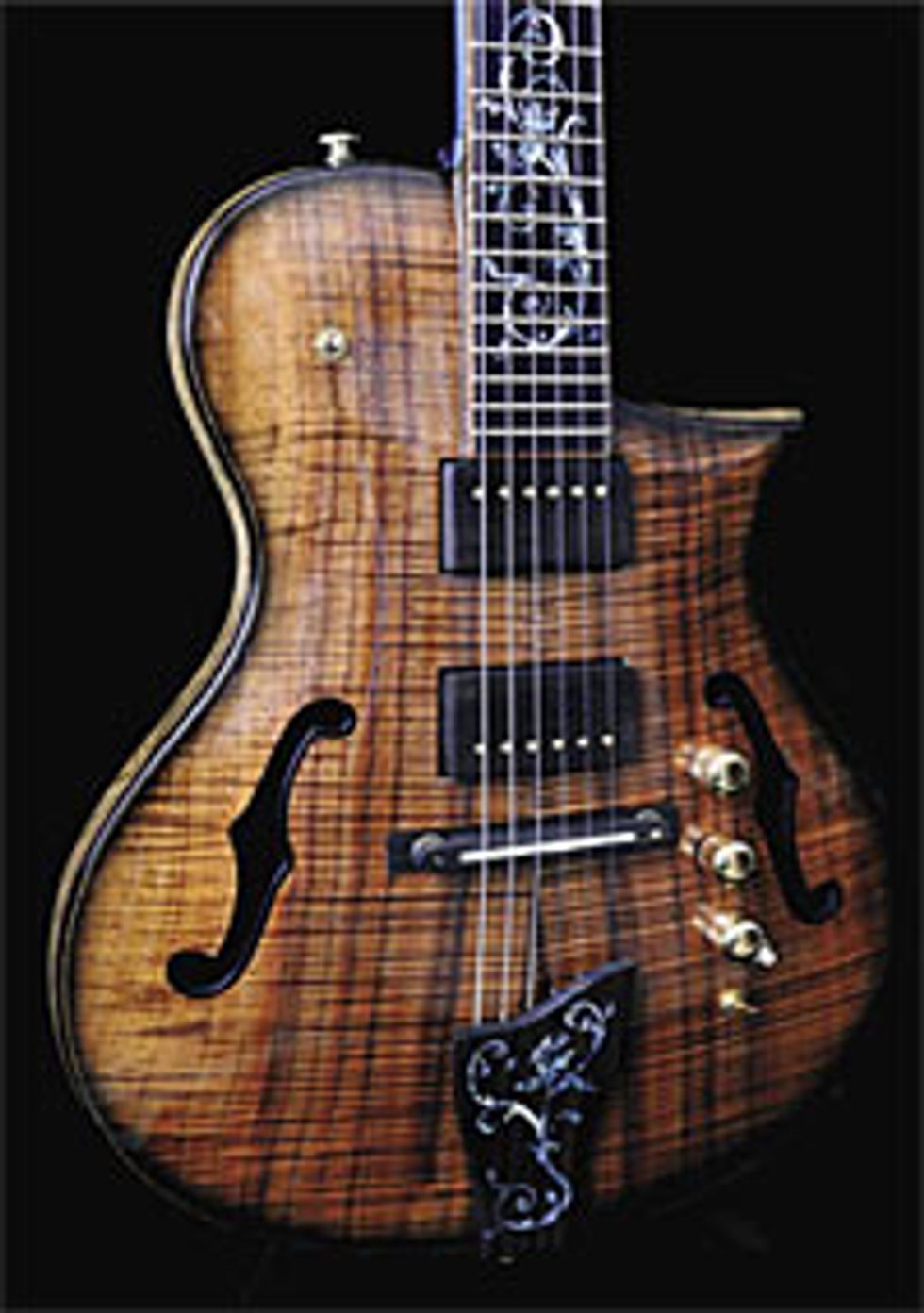 Drea Armani archtop |
I do, because you don’t develop them by pushing a giant button that says START. You just don’t. But I do give those guys credit – they make excellent, consistent products. This is just a different thing.
I’ll never say I’ve mastered the technique of building a guitar. I don’t consider myself a master builder – I’m just a dude that has a little vision. I’ve improved my skills and put them together in a guitar that I feel is probably as great as anything that’s out there. But I won’t settle for that, I gotta keep pushing my skills to the limit.
That drive really shows in your new archtop, the Drea Armani. It’s really a stunning design with a striking cutaway. How did this model come about?
I took a 15” body, which is common with a small-body archtop, and wanted something more player-focused, especially in a stage setting where a bigger box or an acoustic can be kind of cumbersome. I wanted this guitar to be more ergonomic, closer to your body, where you can feel it and it’s not obtrusive.
The cutaway came about by just trying to be non-traditional, to have a little different look from everything else. It’s also ultimately about access towards the top of the guitar. You can’t get your hand in there a lot of times on a traditional guitar, so I thought, “Let’s utilize those notes.”
You showed me a half-finished version of your archtop, and the body design is pretty ingenious.
It’s a neck-thru system; the pickups are actually mounted to the neck-thru block, and they’re not touching the guitar top anywhere; nor is the guitar’s top or back touching any part of the neck-thru truss. There’s nothing connecting the top to the back of the guitar except the sides, meaning the top and back can vibrate freely.
I carve the back in a special way that transmits and pushes that focused sound. Then you have the neck-thru system, which fits in the body tightly, so sustain is maximized. It’s a hollowbody archtop with an independent top and back, and a trem is optional.
I carve the back in a special way that transmits and pushes that focused sound. Then you have the neck-thru system, which fits in the body tightly, so sustain is maximized. It’s a hollowbody archtop with an independent top and back, and a trem.
That’s something you don’t see everyday. What kind of a trem unit are you using?
It’s a top-mounted Skyway tremolo. There’s no back route here – nothing needs to be routed in the back of the guitar; no springs, no claw and no cover plate. And the electronics can’t be loaded in from the top, because you can’t fit the electronics through the pickup holes or the f-holes, so I had to make a side mount where all of the electronics go through. That hole eventually turns into the output jack.
If you don’t choose the trem version, then you would receive the more traditional archtop bridge and tailpiece (all of which is handmade). The cool thing with this design is that I can put in the LB6 saddle transducer, which is an acoustic guitar bridge saddle piezo, so you can blend the humbuckers and the piezo together through the output jack. So if you have a stereo cord, two amps and an A/B box, you can send an acoustic signal to the acoustic amp. With everything you’re playing, there’s going to be an acoustic guitar doubling it. With a mono chord, you can mix the mag signal with the piezo using the blend knob and route that blended signal to one amp. The possibilities are endless.
It seems like a case of form and function working hand in hand.
It’s functional, although I didn’t invent it – any builder can do that right now. I’m just trying to maximize the guitar’s design and sparkling clean tone. The other thing with this design is that I’m trying to get it to where you never lose that archtop vibe on the clean playing, but you can drive the guitar a little harder – you can overdrive it. A lot of people know that if you get overdrive anywhere near acoustic or archtop guitars, they want to take off. I’m not saying you can stand in front of a Marshall stack or hand it to James Hetfield, but you can overdrive this guitar significantly more than a regular archtop, if that’s your thing. However, I figure most people will want to play it cleanly and it was designed for that purpose.
It’s obvious that you’ve been thinking about this design for a long time.
Oh, definitely – you know, the sky’s the limit as far as ideas go. They’re just my vision – imagine going to Rembrandt and saying, “I want you to paint me this, and it’s gotta look like this.” You’re stifling his art. You want to buy what he delivers, and that’s basically what these guitars are.
And really, my ideas are just starting to evolve after doing this for twelve years. Right now, I’m working on acoustics. I want people to have the same reactions you’re having when I go to guitar shows with these guitars. It’s a double take.
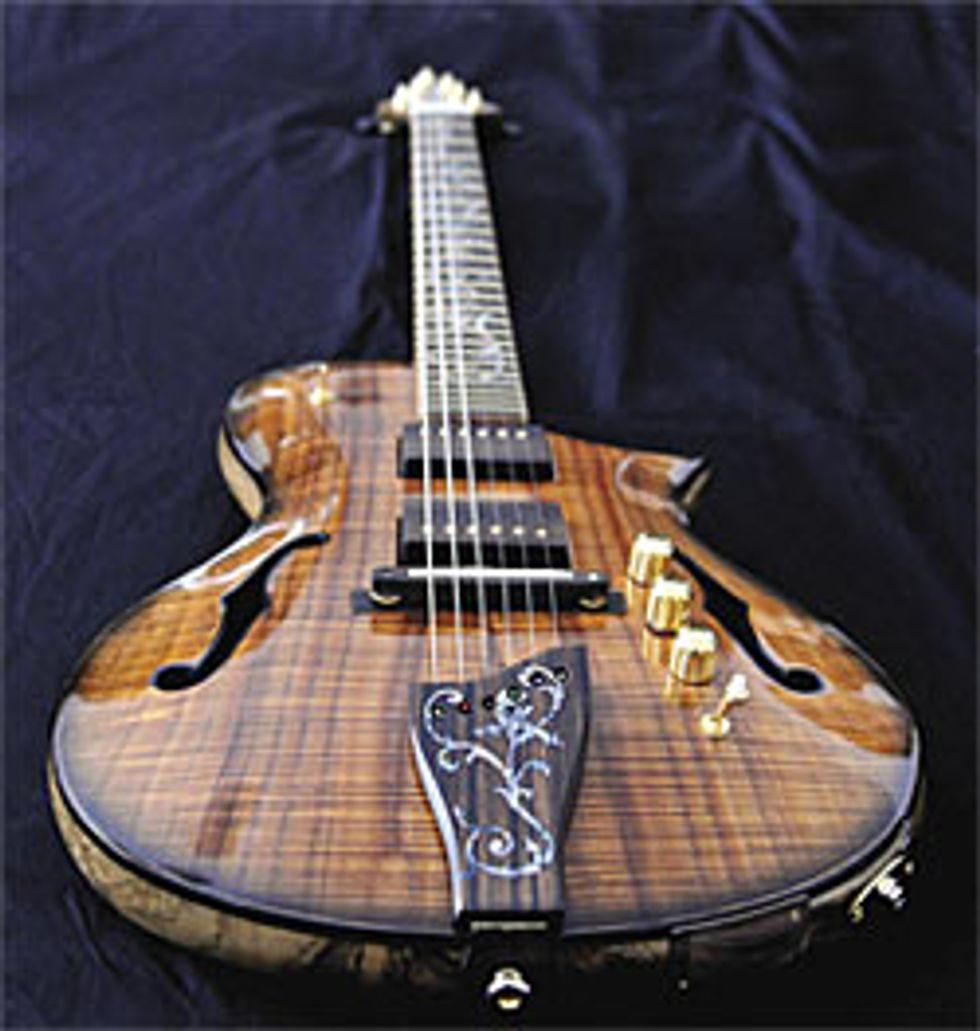 I’ll be honest, when I saw you down at the Dallas International Guitar Festival last year, I was hesitant to pick your guitars up, because they look like works of art.
I’ll be honest, when I saw you down at the Dallas International Guitar Festival last year, I was hesitant to pick your guitars up, because they look like works of art. But they’re absolutely instruments. If it’s your thing, go play it in a smoky bar every night.
Where do all of these ideas come from? Are they of the “Eureka!” kind, or do they form from hard work – sitting down with a sketchpad and putting pencil to paper?
You know what? I gotta be honest with you, there’s several things I think about all the time. I think about God, my family, sex and guitars.
So you’re the average guy!
[laughs] I’m the average guy. And those aren’t in any specific order, but I’m always thinking about guitars. It’s very strange – my kid will be shooting a basket and I’ll be watching, thinking, “I wonder how that part is gonna fit with the other one.” I honestly don’t have enough life in me to get all of the ideas out. I won’t live long enough to get them all out. It’s kind of like a songwriter – that’s what they are, that’s what they emit. That’s the essence of who they are.
Does that mean this is what you were born to do?
I honestly think this is what I was meant to do. It’s about passion, it’s about drive and it’s about weathering the storms.
I take it you’ve had a few?
Yeah, but you’ve got to hang in there, you’ve gotta be who you are. From my perspective, a lot of guys aren’t necessarily who you think they should be. I guess I’m trying to say that I just want to build great guitars and develop actual relationships with these people.
Is it hard to let these guitars go when they’re done?
Dude, it seriously is. After it’s gone, all I’ve got left is a photograph. And I can sit here and describe that guitar to you all day long, but until you put your hands on it and play it, you can’t explain it.
You’re apparently gearing up to change your company’s name from Abyss Guitars to Kevin L. Pederson Custom Guitars. Why the shift from such an bold title to more of a personal one?
Well, when I named the company Abyss in the beginning, I thought people might be more interested in the instruments if it was more of a “corporate” thing – I didn’t want to put my identity on it. I thought, “People aren’t going to take my guitars as seriously if it’s just me.” But over the years of doing this, I realized that people are actually more interested in the fact that it’s just one guy doing it, and they actually like that better than some big corporate thing. So I thought, “Why not just be who I am?” We’re in the age of the custom builder, the boutique, the investment grade, and that’s who I am, so why separate my identity from it now? It just says, “These are Kevin’s guitars.”
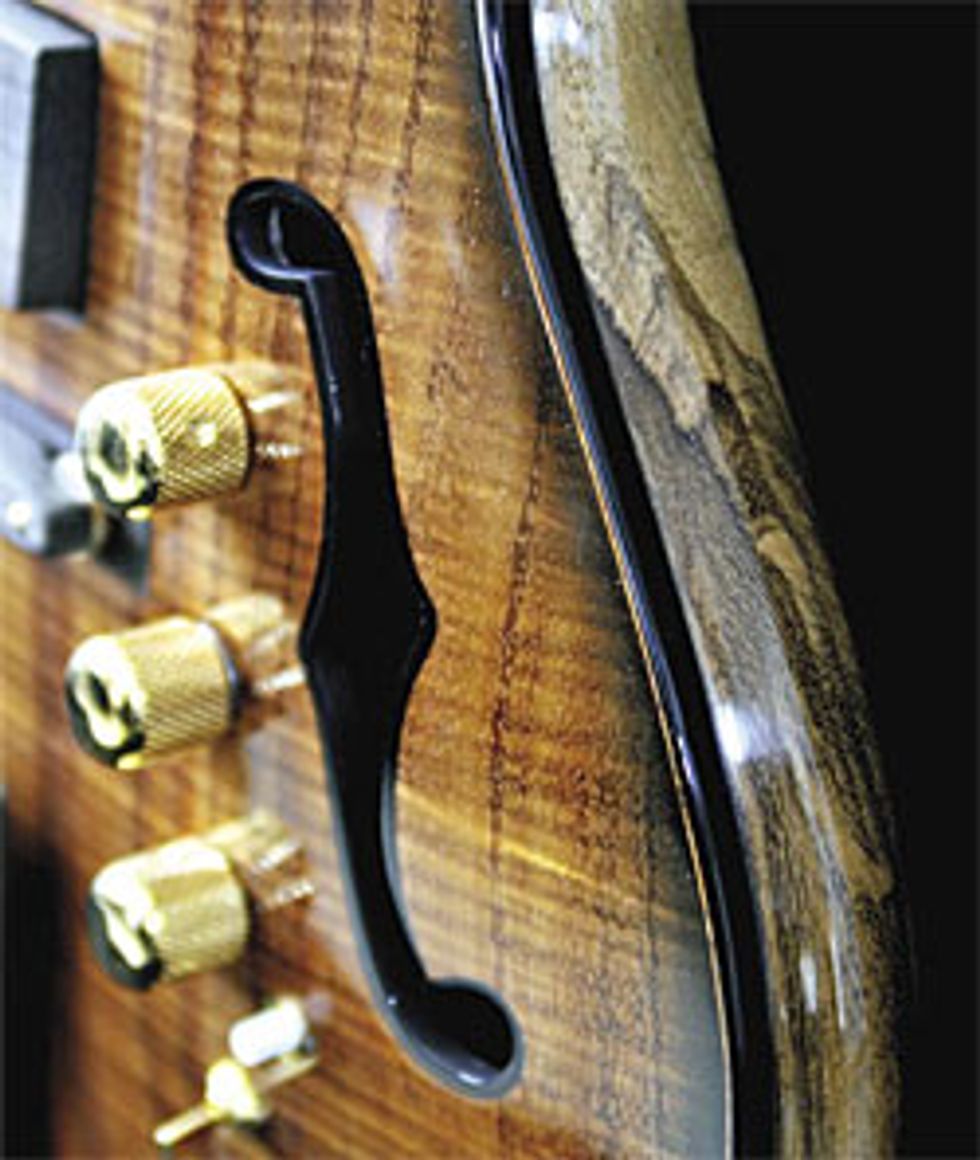 Are you at all worried about people getting confused once you change the name?
Are you at all worried about people getting confused once you change the name? Kind of, yes. I want people to realize that it has always been me doing Abyss. The only thing that’s changing is the name, not the guitars, and they’re going to get better and better. It’s putting my identity directly on the guitar, rather than stepping away from it.
With the name change, it feels like you’ll be stepping into a more exclusive club of high-end custom builders. Are there any guys out there that you look up to?
I look up to all of them, really, because we’re in a fraternity. We should all support each other; I don’t feel like I’m better than any of them. But I want to be honest with the situation – my focus is on producing a handmade custom guitar that nobody else has. For instance, there are several builders out there that are hand making more model-specific guitars. It’s a single cutaway, got flame binding and all that.
But they’re all homogenous in a way.
Yeah, but not in a bad way – that’s their intent. My focus is just more on the individual ideas and the instrument as a whole – the crazy inlays, the way it’s put together.
I would imagine business is pretty good for you – will the name change also bring with it a change in pricing?
It has been pretty good, and you know, over the years of doing this, as each guitar gets more intricate the prices reflect that. But the people ordering realize that it’s like a Harley. If you want a Harley, you have to buy a Harley. Sure, you can buy a Honda that looks like a Harley, you can buy a Yamaha that looks like a Harley, but if you want a Kevin L. Pederson Custom Guitar, you’re going to have to give me a call and we’ll start putting the ideas down. And the truth is I have a shelf life; I’m going to pass on one day, and you only live once, so sometimes you’ve just got to go for it.
Since we’re speaking about the essence of your guitars, you’re known for some pretty intricate, biblically-inspired inlays. Has it been natural for you to merge your religious beliefs with your craft?
I think it has been, because it’s art, it’s who you are; it’s your background. The guitars are a part of me, so obviously it’s going to come out in the guitars. I just feel like we all have a higher purpose. I believe God exists and I feel like you can have a personal relationship through Christ with Him, something you have to receive individually – but I’m not pushing that on people.
I’ve really changed as a person, man. I used to be a party rocker, a total party dude. And God came knocking on my heart and said, “You know what, Kevin, I got a bigger thing for you.” And this is it.
Was guitar building a vehicle out of that previous life?
It was. Some people get hit on the head and it’s an overnight thing. I’m a bit more stubborn – it was a longer road before I was able to change.
Is there something purifying about working with your hands?
Yeah. When I first started working at the cabinet shop in 1995, I had to ask a guy how to change the blade in a jigsaw. So you can see how I see it as a God-inspired change in my life.
Since you’re producing investment-grade instruments, your natural pool of buyers is fairly limited. As a small builder, how do you continue to grow your business?
The website is obviously the hub, the nerve center or whatever you want to call it. Through that I can communicate with my customers – I put my latest news on there, which shows I’ll be attending and so on. I have a lot of people who will email me to let me know they’ll be at the Chicago show in May, for example. Word of mouth is also great, as I have repeat buyers. I have a customer in Orlando who has a $16,000 Presentation Elect on order, and he bought an $11,000 guitar before that.
What kinds of reactions do you get from customers returning to buy another?
My repeat customers are very impressed. They’ve been waiting and they’re expecting something good and they have a lot of anticipation. My goal is to make him smile every time he opens the case. If you can do that, he’ll be happy.
Has it been easy selling these high-end pieces online? One would think that people would still be a bit wary about shipping a deposit check to someone they found on the internet.
Ten years ago you couldn’t fathom somebody paying $8000 for a guitar over the internet. Now that trust is being built, and I think validation of that is that you guys are talking with me. People are now more apt to drop $10,000 on a guitar because the dude in Texas they just emailed said it’s the greatest thing he’s ever seen. So it seems they’re willing to take that trust and come over for a guitar.
As a matter of fact, I have a lot of customers who I’ve never talked to on the phone, never gotten emails from. I get one email, they tell me what they want, I send them a quote, they send me a check, I send them an email telling them it’s done and that’s it.
I think that speaks volumes about the quality of your craftsmanship – there’s an incredible amount of confidence in your work.
Thank you. If I didn’t feel I could do a great job, then I wouldn’t pursue the business. You know, each guitar gets better – the guitars I make now are better than the guitars I made five years ago. I try to get better with each one.
Could you do any of this without the internet?
No. I mean, I could, but think how many years behind I’d be with conventional advertising. You would have to take all my international sales away – guitars sent to Germany, Japan, U.K., Sweden – unless they saw it in a print ad. So it would definitely be tough.
Considering your youthfulness, do you see yourself doing this the rest of your life?
You bet, dude. I can’t even think of retiring.
Kevin L. Pederson Custom Guitars
abyssguitars.com























